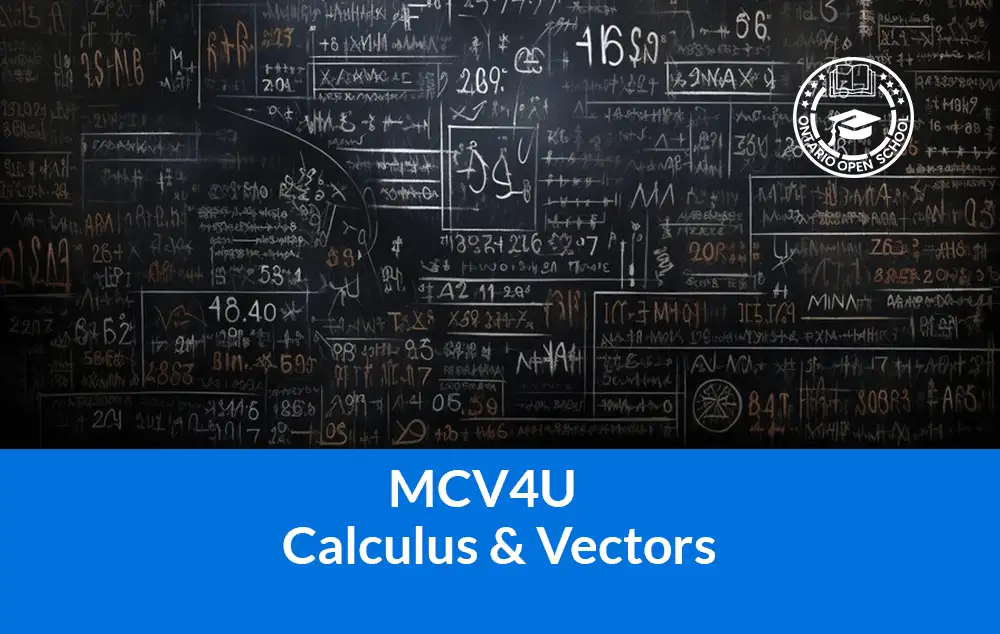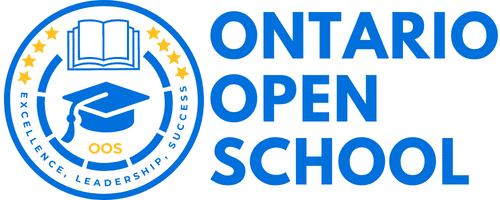- info@ontarioopenschool.com
- 647-494-4499
-
Unit 100 - 29 Gervais Drive, North York, ON.
M3C 1Y9
Copyright 2024 Ontario Open School Inc. All Rights Reserved.
This course builds on students’ previous experience with functions and their developing understanding of rates of change. Students will solve problems involving geometric and algebraic representations of vectors and representations of lines and planes in three-dimensional space; broaden their understanding of rates of change to include the derivatives of polynomial, sinusoidal, exponential, rational, and radical functions; and apply these concepts and skills to the modelling of real-world relationships. Students will also refine their use of the mathematical processes necessary for success in senior mathematics. This course is intended for students who choose to pursue careers in fields such as science, engineering, economics, and some areas of business, including those students who will be required to take a university-level calculus, linear algebra, or physics course.
Unit Order | Unit Name | Suggested Time |
|---|---|---|
| Unit 1 | Vectors There are four main topics pursued in this initial unit of the course. These topics are an introduction to vectors and scalars, vector properties, vector operations and plane figure properties. Students will tell the difference between a scalar and vector quantity, they will represent vectors as directed line segments and perform the operations of addition, subtraction, and scalar multiplication on geometric vectors with and without dynamic geometry software. Students will conclude the first half of the unit by proving some properties of plane figures, using vector methods and by modeling and solving problems involving force and velocity. Next students learn to represent vectors as directed line segments and to perform the operations of addition, subtraction, and scalar multiplication on geometric vectors with and without dynamic geometry software. The final topic involves students in proving some properties of plane figures using vector methods. | 13 Hours |
| Unit 2 | Linear Dependence and Coplanarity Cartesian vectors are represented in two-space and three-space as ordered pairs and triples, respectively. The addition, subtraction, and scalar multiplication of Cartesian vectors are all investigated in this unit. Students investigate the concepts of linear dependence and independence, and collinearity and coplanarity of vectors. | 12 Hours |
| Unit 3 | Vector Applications Applications involving work and torque are used to introduce and lend context to the dot and cross products of Cartesian vectors. The vector and scalar projections of Cartesian vectors are written in terms of the dot product. The properties of vector products are investigated and proven. These vector products will be revisited to predict characteristics of the solutions of systems of lines and planes in the intersections of lines and planes. | 10 Hours |
| Unit 4 | Intersection of Lines and Planes This unit begins with students determining the vector, parametric and symmetric equations of lines in R2 and R3. Students will go on to determine the vector, parametric, symmetric and scalar equations of planes in 3-space. The intersections of lines in 3-space and the intersections of a line and a plane in 3-space are then taught. Students will learn to determine the intersections of two or three planes by setting up and solving a system of linear equations in three unknowns. Students will interpret a system of two linear equations in two unknowns geometrically and relate the geometrical properties to the type of solution set the system of equations possesses. Solving problems involving the intersections of lines and planes and presenting the solutions with clarity and justification forms the next challenge. As work with matrices continues students will define the terms related to matrices while adding, subtracting, and multiplying them. Students will solve systems of linear equations involving up to three unknowns, using row reduction of matrices, with and without the aid of technology and interpreting row reduction of matrices as the creation of new linear systems equivalent to the original constitute the final two new topics of this important unit. | 12 Hours |
| Unit 5 | Concepts of Calculus A variety of mathematical operations with functions are needed to do this course’s calculus. This unit begins with students developing a better understanding of these essential concepts. Students will then deal with rates of change problems and the limit concept. While the concept of a limit involves getting close to a value but never getting to the value, often the limit of a function can be determined by substituting the value of interest for the variable in the function. Students will work with several examples of this concept. The indeterminate form of a limit involving factoring, rationalization, change of variables and one sided limits are all included in the exercises undertaken next in this unit. To further investigate the concept of a limit, the unit briefly looks at the relationship between a secant line and a tangent line to a curve. To this point in the course students have been given a fixed point and have been asked to find the tangent slope at that value, in this section of the unit students will determine a tangent slope function similar to what they had done with a secant slope function. Sketching the graph of a derivative function is the final skill and topic | 10 Hours |
| Unit 6 | Derivatives The concept of a derivative is, in essence, a way of creating a short cut to determine the tangent line slope function that would normally require the concept of a limit. Once patterns are seen from the evaluation of limits, rules can be established to simplify what must be done to determine this slope function. This unit begins by examining those rules including: the power rule, the product rule, the quotient rule and the chain rule followed by a study of the derivatives of composite functions. The next section is dedicated to finding the derivative of relations that cannot be written explicitly in terms of one variable. Next students will simply apply the rules they have already developed to find higher order derivatives. As students saw earlier, if given a position function, they can find the associated velocity function by determining the derivative of the position function. They can also take the second derivative of the position function and create a rate of change of velocity function that is more commonly referred to as the acceleration function which is where this unit ends. | 10 hours |
| Final Evaluation 30% | Final Project Final Exam | 6 hours 2 hours |
| Total | 110 Hours |
Additional Teaching/Learning Strategies for International Students
Purpose
The primary purpose of assessment is to improve student learning. Assessment relates directly to the expectations for the course.
A variety of assessments for and as learning are conducted on a regular basis to allow ample opportunities for students to improve and ultimately demonstrate their full range of learning and for the teacher to gather information to provide feedback. Assessment tasks relate to the success criteria set out in lesson plans. Success criteria allow students to see what quality looks like.
Evaluation is the process of judging the quality of student work in relation to the achievement chart categories and criteria and assigning a percentage grade to represent that quality. Evaluation is based on gathering evidence of student achievement through:
Assessment for Learning – we provide feedback and coaching. Assessment FOR Learning is the process of seeking and interpreting evidence for the use of learners and their teachers to decide where the learners are in their learning, where they need to go, and how best to go there.
Assessment as Learning – we help students monitor progress, set goals, reflect on their learning
Assessment AS Learning is the process of the explicit fostering of students’ capacity over time to be their own best assessors, but teachers need to start by presenting and modeling external, structured opportunities for students to assess themselves.
Assessment of Learning – we use assessments to provide evaluative statements about student achievement. Assessment OF Learning is the assessment that becomes public and results in statements of symbols
(marks/grades/levels of achievement) about how well students are learning. It often contributes to pivotal decisions that will affect students’ future.
ASSESSMENT TOOLS
|
70% |
Units/ Allocated Time/ Overall Expectation
|
Assessment For and As Learning
|
Assessment of Learning (Evaluation) |
|
Unit 1 |
– homework
– Class discussion – Check list for the unit(self-assessment) – Desmos Activities – What did I learn in this unit
|
Test 1 |
|
|
Unit 2 |
-(homework)
– Exit ticket -Class discussion -Groupwork (peer assessment) -Anecdotal notes per chapter – Entry Cards |
Assignment
|
|
| Unit 3 | – (homework)
-Check list at the end of each chapter(self-assessment) -Anecdotal notes at the end of each week Exit ticket(self-assessment) – pair work (peer assessment) – Checklist – Worksheet – Exit Card – Entry Card
|
Test 2 Presentation
|
|
|
Unit 4,5 |
Test 3 |
||
|
Unit 6,7 |
-Checklist
-Worksheet -Exit Card -Entry Card -Discussion (peer assessment)
|
Test 4 |
|
|
Unit 8 |
-KWL Chart
-What did I learn in this unit? |
Model making and Presentation | |
| 30% | -A1/A2/A3
-B1/B2 -C1/C2/C3/C4 |
Final Exam (30%) |
There are four levels of achievement for students who are passing this course:
Level 1 – (50-52%) Level 3 – (70-72%)
Level 1 (53-56%) Level 3 (73-76%)
Level 1+ (57-59%) Level 3 + (77-79%)
Level 2 – (60-62%) Level 4 – (80-86%)
Level 2 (63-66%) Level 4 (87-94%)
Level 2 + (67-69%) Level 4 + (95-100%)
Level 3 is the provincial standard for student achievement.
A wide range of assessment strategies (tests, portfolios, journals, essays, presentations, observation, conferencing and projects), combined with an array of instrument tools (including detailed marking schemes, checklists, rubrics and exemplars), is used in order to measure student achievement of overall course expectations.
Resources
Grading
Weighting of categories
| Knowledge/Understanding | Thinking/Inquiry | Communication | Application |
| 25% | 25% | 25% | 25% |

Course Grade | Grade 12 |
|---|---|
Course Code | MCV4U |
Course Category | Mathematics |
Course Type | University Preparation |
Course Delivery | Online |
Course Duration | 8hrs |
Course Credit | 0 |
Copyright 2024 Ontario Open School Inc. All Rights Reserved.
